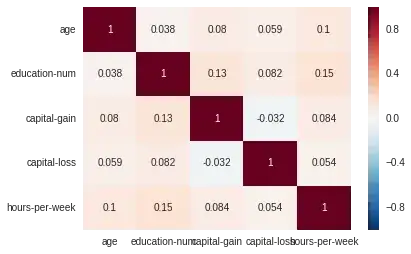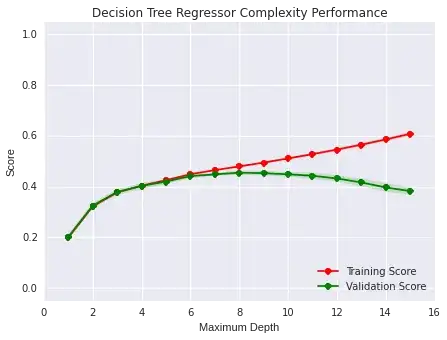I'm working on a project from Udacity's ml nd, finding donors,
I'm making the initial test using three algorithms:
LogisticRegression -> RED
GaussianNB -> Green
AdaBoostClassifier -> Blue
This is the result I'm getting:
I wonder why nb has such a poor performance. This is some informations regarding the dataset:
1) Initial numerical features are not highly correlated:
2) There are categorical features on that were encoded increasing the number of features up to 100 and making the dataset more sparse.
Edit:
I also tried using decision Trees,these has a poor performace too, best case is around 0.45 for depth 8 over that it starts presenting a high variance, which can explain why Adaboost works well on this model since it's main advantage is it's capacity for improving the variance issue.
I still have the doubt of why NB and DT have such a poor performance on this dataset compared with the logistic regression which is a simple model too.
EDIT:
This is the code I have used
from sklearn.linear_model import LogisticRegression
# Import the three supervised learning models from sklearn
from sklearn.naive_bayes import GaussianNB
from sklearn.tree import DecisionTreeClassifier
from sklearn.svm import SVC
from sklearn.ensemble import AdaBoostClassifier
# Initialize the three models
clf_A = LogisticRegression(penalty='l2')
clf_B = GaussianNB()
clf_C = AdaBoostClassifier()
# Calculate the number of samples for 1%, 10%, and 100% of the training data
def get_sample_size(percentage):
return int((float(percentage)/100)*X_train.shape[0])
samples_1 = get_sample_size(1.0)
samples_10 = get_sample_size(10.0)
samples_100 = get_sample_size(100.0)
# Collect results on the learners
results = {}
for clf in [clf_A, clf_B, clf_C]:
clf_name = clf.__class__.__name__
results[clf_name] = {}
for i, samples in enumerate([samples_1, samples_10, samples_100]):
results[clf_name][i] = \
train_predict(clf, samples, X_train, y_train, X_test, y_test)
# Run metrics visualization for the three supervised learning models chosen
vs.evaluate(results, accuracy, fscore)
def train_predict(learner, sample_size, X_train, y_train, X_test, y_test):
'''
inputs:
- learner: the learning algorithm to be trained and predicted on
- sample_size: the size of samples (number) to be drawn from training set
- X_train: features training set
- y_train: income training set
- X_test: features testing set
- y_test: income testing set
'''
results = {}
# TODO: Fit the learner to the training data using slicing with 'sample_size' using .fit(training_features[:], training_labels[:])
start = time() # Get start time
learner.fit(X_train[:sample_size], y_train[:sample_size])
end = time() # Get end time
# TODO: Calculate the training time
results['train_time'] = end - start
# TODO: Get the predictions on the test set(X_test),
# then get predictions on the first 300 training samples(X_train) using .predict()
start = time() # Get start time
predictions_test = learner.predict(X_test)
predictions_train = learner.predict(X_train[0:300])
end = time() # Get end time
# TODO: Calculate the total prediction time
results['pred_time'] = end - start
# TODO: Compute accuracy on the first 300 training samples which is y_train[:300]
results['acc_train'] = accuracy_score(y_train[0:300],predictions_train)
# TODO: Compute accuracy on test set using accuracy_score()
results['acc_test'] = accuracy_score(y_test,predictions_test)
# TODO: Compute F-score on the the first 300 training samples using fbeta_score()
results['f_train'] = fbeta_score(y_test,predictions_test,0.5)
# TODO: Compute F-score on the test set which is y_test
results['f_test'] = fbeta_score(y_test,predictions_test,0.5)
# Success
print "{} trained on {} samples.".format(learner.__class__.__name__, sample_size)
# Return the results
return results
The dataset is available here:


